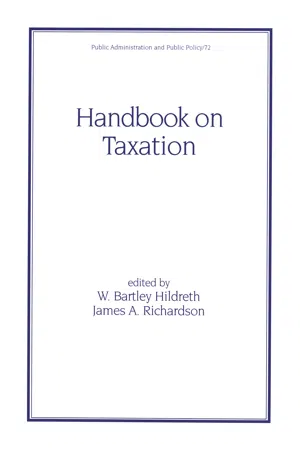Corporate Income Tax
Corporate income tax is a tax levied on the profits of corporations. It is based on the net income of the company and is typically calculated by applying a specific tax rate to the taxable income. Corporations are required to file annual tax returns and pay the applicable corporate income tax to the government.
5 Key excerpts on "Corporate Income Tax"
- eBook - ePub
CFO Fundamentals
Your Quick Guide to Internal Controls, Financial Reporting, IFRS, Web 2.0, Cloud Computing, and More
- Jae K. Shim, Joel G. Siegel, Allison I. Shim(Authors)
- 2012(Publication Date)
- Wiley(Publisher)
...PART EIGHT Taxation CHAPTER THIRTY-FIVE Tax Factors in Financial Decision Making There are many taxing agencies, including federal, state, and local, to which your company pays tax. If your company is operating internationally, it has the additional problem of applying tax laws of foreign countries. Taxes may be levied on income, sales, and property. The federal Corporate Income Tax (filed on Form 1120) is the most important because it often represents the largest tax liability. Thus, it can have a major effect on your financial decisions. WHAT SHOULD YOU KNOW ABOUT TAXES? To make sound financial and investment decisions, you must have an understanding of the basic concepts underlying the U.S. tax structure and how they affect your decisions. This section discusses first the general structure of the Corporate Income Tax, such as taxable income, capital gains and losses, deductible expenses, operating loss carrybacks and carryforwards, tax rates, and tax prepayments and credits. Then it reviews various tax planning strategies to minimize your company’s income tax liability in the current year and postpone the payment of taxes to later years. The advantages of electing S corporation status also are discussed. The general tax formula for corporations is: A brief review of the various elements of this tax formula will provide a general understanding needed for effective tax planning. GROSS INCOME What does gross income consist of? Corporate gross income is of two types: 1. Ordinary income, which includes income from normal business operations as well as miscellaneous incomes, such as rents, interest, and dividends. Ordinary income is fully taxable; however, the corporation has a special exclusion for dividends received from taxable domestic corporations. Generally, 70 percent of the dividends received can be excluded from the corporation’s gross income...
- eBook - ePub
- Raghbendra Jha(Author)
- 2009(Publication Date)
- Routledge(Publisher)
...19 Tax incentives and corporate taxation DOI: 10.4324/9780203870044-19 Key concepts: Corporate tax policy; tax competition, tax incentives; tax holidays; effective tax rates. 19.1 Introduction This chapter deals with some issues relating to corporate taxation in a modern open economy. We first discuss the broad rationale for a corporation tax. Then we discuss various tax incentives that have been studied in the context of corporate profits. Finally, we compute effective tax rates in the context of modern tax structures designed to stimulate investment. Corporate taxation is a key element of modern tax structures. However, in a distinct sense the rationale for a corporation tax is tenuous. If corporations are ultimately owned by shareholders then corporate profits should not be taxed separately as these are taxed as dividend and/or income tax. Two justifications for a separate corporate tax have been discussed in the literature: first, a considerable fraction of profits are retained by the corporations and are not taxed (at least in the same period as the profits are realized) at the level of the individual since these profits do not accrue to individuals; and, second, there may be monopoly elements in the corporate sector necessitating corrective taxation on their own. The corporate tax or Corporate Income Tax differs from the individual income tax in two major ways. First, it is a tax not on gross income but on net income, or profits, with permissible deductions for most costs of doing business. Second, in many countries it applies only to businesses that are chartered as corporations – not to partnerships or sole proprietorships. In some countries the corporate tax is a flat percentage amount whereas in some other countries (e.g., USA) different tax rates apply to different profit brackets. The rationale for this is that the lower tax rate is supposed to benefit small corporations...
- eBook - ePub
- W.Bartley Hildreth, W.Bartley Hildreth(Authors)
- 2019(Publication Date)
- Routledge(Publisher)
...Although substantial, the share of government receipts from the corporate tax has been falling, and represents less than 12 percent of overall receipts (Fig. 2). 12 Table 1 Selected Items Included in the U.S. Corporation Income Tax Base, 1993 (Dollar Values in Millions) III. ECONOMIC AND BEHAVIORAL EFFECTS OF THE Corporate Income Tax As with any tax, the existence of the corporate tax may alter the behavior of those subject to it as they seek to minimize their tax liability or invest in tax-favored activities. Indeed, concerns over the neutrality of the Corporate Income Tax have been cited as the reason for any number of proposed and enacted changes in the tax code. By neutrality it is meant that the tax system should not change the relative rates of return on different investments from what they would otherwise be in equilibrium in the absence of taxation. 13 In the following four sections we discuss the reasons why taxes might be expected to influence specific aspects of firm’s behavior. These sections are not meant to be a comprehensive review of taxes on corporations, but rather highlight areas that have received particular attention: organizational form, capital structure, capital investment, and dividend policy. It is important to note, however, that taxes are only one of the many financial and nonfinancial factors firms must consider when making decisions. As a result, the advantage-or disadvantage-of undertaking any action because of taxes may be mitigated or completely offset by other considerations. 14 Figure 2 Corporate Income Tax receipts. From Executive Office of the President (1996). A. Organizational Form One of the earliest and most fundamental decisions a business must make is the type of organizational form it will use. 15 Businesses must choose among operating as a sole proprietorship, a partnership, or a corporation—each with its own nontax and tax advantages and disadvantages...
- Gary Bandy(Author)
- 2014(Publication Date)
- Routledge(Publisher)
...A duty is levied on a thing. Most public managers do not need to concern themselves with issues relating to tax collection but they need to manage the collection of any other income that specifically relates to their service or project. Senior managers need to be assured that taxes (and other income) are being collected efficiently otherwise the viability of the organization will be jeopardized. Key Terms Direct tax – a tax where the legal taxpayer and the economic taxpayer are the same person (whether a natural person or a corporate body). Economic taxpayer – the person who ultimately bears the burden of the tax. Indirect tax – a tax where the legal taxpayer is not the economic taxpayer. Legal taxpayer – the person who is liable to make the payment of tax to the government. Tax base – the value of assets, property or transactions that are subject to a particular tax. Tax rate – the amount that is applied to the tax base to determine the amount of tax that is payable for a given period. The rate of tax can be regressive, neutral or progressive. The art of taxation consists in so plucking the goose as to obtain the largest amount of feathers with the least amount of hissing. (Jean Baptiste Colbert, cited by Brooks, 2010) The principal sources of income for governments, non-profit organizations and private sector, profit-seeking organizations is one of the distinguishing features between them (Moore, 2000 : 185). For governments the principal source of income is taxation, something that is only available to government. Non-profits are distinguished by the income they receive from charitable donations. Whilst governments and non-profits receive some income from the fees charged for products and services this source of income is much more relevant to profit-seeking organizations...
- eBook - ePub
Federal Income Tax
a QuickStudy Digital Law Reference
- Elena Marty-Nelson(Author)
- 2019(Publication Date)
- QuickStudy Reference Guides(Publisher)
...Corporate Income Tax Types Of Businesses • “C” CORPORATION Entity created by law with associates and profit motive Financing Debt (bonds and notes) Promise to pay interest and repay loan Holder is creditor Corporation can deduct interest with some limitations [§163] Business interest deduction for year not to exceed sum of business interest income, 30% of adjusted taxable income, and floor plan financing interest carryforward allowed for disallowed interest. [§163(j)] Limitation on business interest deduction does not apply for certain small businesses (businesses with average annual gross receipts of $25 million or less). Equity (common and preferred stock) Evidence of ownership Shareholder may receive dividends [§316] Dividend represents payment of earnings after expenses Corporation can’t deduct dividends paid Issuer’s classification binds issuer and holders [§385(c)] Taxation Basic computation much like individual’s Taxed at flat rate of 21% [§11] • “S” CORPORATION 100 shareholders maximum and 1 class of stock [§1361] Family members treated as 1 shareholder [§1361(c)(1)] “S” status must be elected by all shareholders [§1362(a)(2)] Generally pays no tax, much. like partnership [§1363] Income and deductions pass through to shareholders [§1366] • UNINCORPORATED ENTITIES Business entities other than corporations and publicly traded partnerships can select tax status [Reg. §§301.7701-2, -3] Referred to as “check-the-box” regulations Single-owner entities disregarded as separate from owner unless they elect corporate status Multiple-owner entities treated as partnerships unless they elect corporate status • PARTNERSHIP Unincorporated organization established to carry on business [§§761, 7701(a)(2)] Pays no tax; income and deductions allocated to partners [§§701–702] Publicly traded partnership treated as a corporation [§7704] • NONBUSINESS TRUST Created by a will or inter vivos declaration to protect trust property for beneficiaries [Reg...




